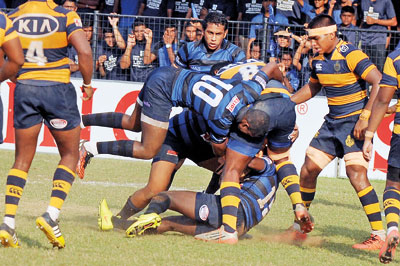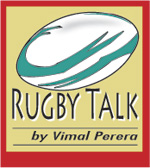Rugby’s contradictions and confusions
 S.Thomas’s College won the Gunaratne Trophy much against play and the dominating Royal maul. The try by Naveen Henakankanamge sealed the game which would have been won much earlier if the boys from mount played to their strength and also taken the decisions that should have been taken. Despite the win, talk still circles around the maul and the referee.
S.Thomas’s College won the Gunaratne Trophy much against play and the dominating Royal maul. The try by Naveen Henakankanamge sealed the game which would have been won much earlier if the boys from mount played to their strength and also taken the decisions that should have been taken. Despite the win, talk still circles around the maul and the referee.The non-contest of line out and the issues were clarified by the World Rugby then IRB based on two question raised by a constituent body. A simplified version of the questions were
That team ‘A’ throws the ball and wins and players bind to the jumper. Team ‘B’ do not contest and do not bind as we have seen in some recent matches. Team ‘A’ then pass the ball to a rear group player and advance. Team B now cannot engage as the ball carrier is not in front. The maul law requires a player from each side to be bound over a player with the ball. Since the ball is behind a player from ‘A’ who is in front technically B is cannot form a maul or will find it difficult to tackle.
The question was: whether this obstruction and can team ‘A’ be penalized. This clarification was sought in 2009 and the world rugby ruling by Designated Members was that the original ball carrier is no longer in contact with the ball, it is not possible for the opposition to form a maul by contact with the ball carrier.
The Referee will award a penalty kick in accordance with Law for obstruction but where the Referee considers the actions constitute accidental offside in accordance with Law a scrum is awarded with the throw in to the non-offending team.
The decision as people see is so simple when you look it from the outside and possibly think that the referee did make mistakes and ask the divine to intervene and bring referees from outside. The joke however is on the one who advised a ministering angel to bring referees from Thailand. The simple non contest in a line out in 2006 and 2009 has reached new and more complications. When you don’t contest a line out and player of one team bind to the ball carrier but there is no maul as the law states; in this situation there are a number of decision that can be taken by the referees.
If the defenders in the line-out choose to not engage the line-out by ‘leaving the line-out as a group’. Then they are penalized for leaving a line-out. 
If the defenders in the line-out choose to not engage the line out drive by simply opening up a gap and ‘creating space’ and not leaving the line-out the attackers would need to keep the ball with the front player, if they were to drive down-field (therefore play on, general play – defenders could either engage to form a maul, or tackle the ball carrier only).
If they immediately pass it back to the player at the rear of the ‘group’, the referee will tell them to ‘use it’ which they must do immediately. If they drive forward with the ball at the back (did not release the ball), the referee will award a scrum for ‘accidental offside’ rather than Penalty.
On the other hand what the referee has to look regarding the attacking team formation is ensure that the ball is not transferred from the Jumper to the rear group player before a proper maul is formed. Then it is Obstruction and a penalty follows.
It is not that simple to get there and referee as he has many options as in this case of a non-contested line-out and a pseudo maul formation. The referee has to make a decision was it obstruction and or was it accidental.
On one match a referee may penalize and another may give accidental off side as happened in two matches last week. What happens next is that you talk of one match where the referee gives a scrum for accidental offside and then ask why a penalty in another match and then talk of inconsistency of a referee.
The referee has to decide whether it is intentional obstruction as in the case of a ball been sent back before the maul formation or was it accidental as the people did not accept a maul. The referee will take the decision that he sees is best and if obstruction is not clear then it will be a scrum. What was suggested as a simple remedy by a critic when this was explained was to say avoid confusion just penalize all.
The law does not say that you cannot pre-bind and move forward but people tend to think that you cannot and it is a flying wedge. The law on a flying wedge is different and is in other circumstances. I can say one law that says you can pre-grip is permitted at the line out. Therefore it follows that at a line out when you pre-grip and the jumper comes down there is a pre- bind.
The contradictions are numerous but the need to get a game going the referee has to decide what he should whistle for. Again take the case of a player being supported to take a high ball say at a kick off. There is a pre-grip and a following bind. Royal does it well so what is needed is a plan to defend.
* Vimal Perera is a former player, coach, referee and an IRB Accredited Referees’ Educator


